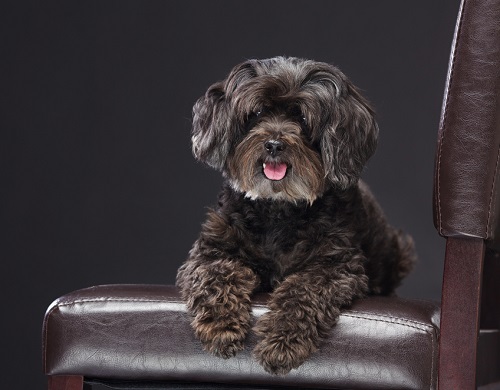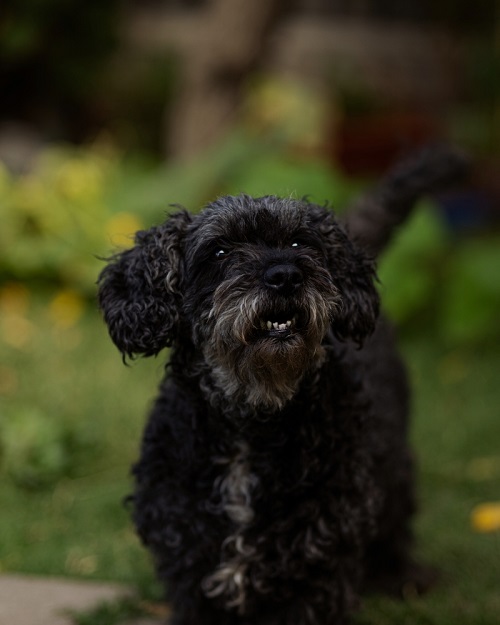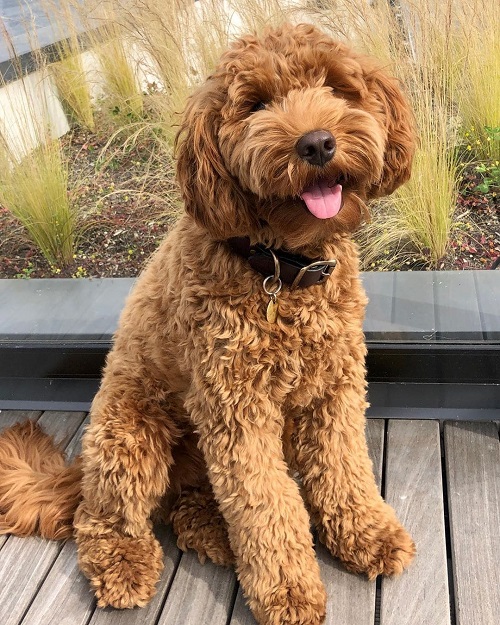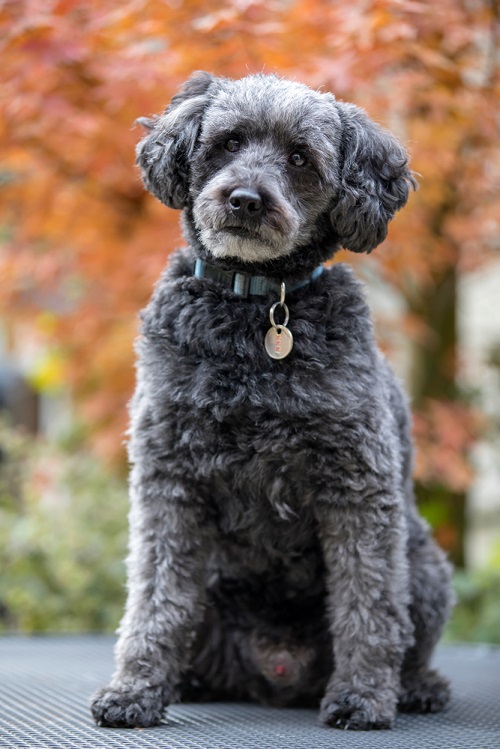Get ready to melt hearts with the Snickerdoodle Dog—a breed that’s as cute as its name! Learn about their playful charm here!
Meet the Snickerdoodle Dog Breed– a delightful blend of sweetness and spunk! This cute dog breed will fill your life with snuggles, smiles, and endless adventures. Learn all about them today!
What is a Snickerdoodle Dog?

The Snickerdoodle Dog, also known as the Schnoodle, is a designer dog breed that’s a cross between a poodle and a schnauzer. These dogs showcase a delightful combination of physical features from both parent breeds.
The notable traits of this dog breed are their high energy and active nature. One aspect that makes Snickerdoodles appealing to many is their hypoallergenic properties. As with most poodle crossbreeds, they typically shed minimally, making them suitable for individuals with dog allergies.
In terms of temperament, they often inherit the protectiveness commonly associated with schnauzers. This doesn’t imply aggression, though, as they are known for their loyalty and affection towards their owners. They can make excellent family pets and tend to get along well with children. Early socialization with kids during puppyhood helps foster positive interactions.
Snickerdoodle dogs have their unique ways of communicating their needs, whether through whining or using their paws to signal. Their loving and attentive nature adds to their charm, making them a beloved choice for dog parents seeking a devoted companion.
What Does a Snickerdoodle Dog Look Like?
The Snickerdoodle Dog breed boasts a unique and adorable appearance that sets them apart from other breeds. They typically have a compact and sturdy body, and their size can range from small to large, depending on the size of the Poodle parent. Their fluffy fur comes in a variety of colors, including white, golden brown, black, or a combination of these.
One notable feature is the lighter-colored points on their tails, reminiscent of a raccoon’s tail. What makes them even more appealing is their low shedding and minimal grooming needs, thanks to their sleek physique.
The Snickerdoodle’s face is expressive, featuring round, bright eyes and a black or brown nose. They have floppy ears that hang close to their cheeks, adding to their adorable charm. These dogs are undeniably adorable that will lure you into cuddling them, whether you see them on the road or are lucky to own one!
Breed Characteristics of the Snickerdoodle Dog

- Playful and Energetic: They are known for their high energy levels and playful nature. They enjoy interactive playtime and thrive in an environment that provides mental and physical stimulation.
- Intelligent and Trainable: With their poodle heritage, they are typically intelligent and quick learners. They respond well to positive reinforcement training methods and enjoy mental challenges.
- Affectionate and Loyal: They form strong bonds with their owners and are often devoted and affectionate companions. They enjoy being part of the family and thrive on human interaction and attention.
- Good with Children and Families: Snickerdoodles are generally friendly and tolerant, making them suitable for families with children. Proper socialization during puppyhood helps them develop positive interactions with kids and other pets.
- Protective Nature: Inherited from their schnauzer lineage, They can exhibit protective instincts towards their family. While not aggressive, they may alert their owners to potential threats or strangers.
- Low-Shedding and Hypoallergenic: They often have a low-shedding coat, making them a favorable choice for individuals with allergies. Their hypoallergenic qualities stem from their poodle heritage.
- Adaptability: Snickerdoodles can adapt well to different living situations, whether in apartments or houses, as long as they receive sufficient exercise and mental stimulation. They are versatile and can adjust to various lifestyles.
- Socialization Needs: Proper socialization from an early age is crucial for them to develop good manners and positive behavior around people and other animals. This helps them become well-rounded and confident dogs.
- Moderate Exercise Requirements: While they are energetic, they typically do not require excessive exercise. Daily walks, playtime, and mental stimulation are usually sufficient to keep them content and prevent behavioral issues.
- Lifespan and Health: Snickerdoodles Dogs generally have a lifespan of around 10 to 15 years. Like all dogs, they may be prone to certain health conditions, including joint issues, eye problems, and dental care needs.
When does Catahoulas Calm Down? Learn here
Common Variations of Snickerdoodle Dog Breed

As discussed earlier, the term “Snickerdoodle Dog” is commonly used to refer to mixed-breed dogs that are a cross between a poodle and a schnauzer. Some common Schnauzer-Poodle Mixes, depending on their appearance, include:
1. Miniature Snickerdoodle Dog
Miniature Snickerdoodle dogs, with their small size, hypoallergenic curly coat, and expressive faces, are just irresistible. From their adorable floppy or button ears to their delightful beard and coat colors, they will simply win your heart. If you’re looking for a tiny, charming Snickerdoodle buddy, you’ve found it!
2. Teacup Snickerdoodle Dog
Please keep in mind that there’s no official breed named “Teacup Snickerdoodle Dog.” The term “teacup” usually refers to super small versions of certain dog breeds but isn’t an officially recognized category. When talking about Snickerdoodle Dogs, breeders might use “teacup” to mean, especially small Snickerdoodles.
3. Brown Snickerdoodle Dog
You’ll be delighted by the warm coat of a brown Snickerdoodle Dog, which can range from light caramel to deep chocolate shades. This beautiful brown fur adds a refined touch to their overall look.
4. Black Snickerdoodle Dog
They boast a sleek and striking appearance with their lustrous black coat, which is often dense and may have a curly or wavy texture, depending on their genetic lineage. The deep black color adds an air of sophistication and elegance to their overall presence. With their captivating dark eyes and expressive features, black Snickerdoodle dogs exude a sense of charm and mystery.
How Does Snickerdoodle Dog Puppy Looks Like?
Snickerdoodle dog puppies are the epitome of cuteness! With their fluffy and sometimes fuzzy fur, they possess an irresistible charm. These playful bundles of joy exude boundless energy and curiosity as they explore their surroundings. Their puppy features, such as button noses and adorable eyes, make them simply irresistible.
When Snickerdoodle Dog Is Full Grown?
A fully-grown Snickerdoodle dog’s size will depend on the size of the parent breeds involved in the mix. Here are some general characteristics of a full-grown Snickerdoodle Dog:
- Size: Snickerdoodle dogs can vary in size, ranging from small to medium or large, depending on the size of the parent breeds. They typically stand around 20 to 24 inches (50 to 61 centimeters) at the shoulder. However, it’s crucial to note that individual variations in size can occur, as factors such as genetics and specific breeding lines can influence the size of a Snickerdoodle dog.
- Weight: The weight of a full-grown Snickerdoodle dog can range from approximately 20 to 75 pounds, again depending on the size of the parents and the specific breeding.
Ideal Diet for Snickerdoodle Dog Breed
The dietary requirements of a Snickerdoodle Dog depend on various factors, including age, size, activity level, and overall health, necessitating personalized advice from a veterinarian.
Generally, their diet should be balanced, consisting of high-quality protein, healthy fats, and carbohydrates, ideally from commercially available dog food specially formulated for their age and size. Maintaining appropriate portion sizes is crucial to avoid obesity or nutrient deficiencies.
Incorporating good quality animal proteins such as chicken, turkey, beef, or fish is important for muscle development. Adding fruits and vegetables can provide essential vitamins, minerals, and dietary fiber. However, certain ones like grapes, raisins, onions, and garlic should be avoided as they can be toxic to dogs.
Constant access to fresh water is vital for hydration and overall well-being. Special dietary needs or sensitivities may exist in some Snickerdoodles, requiring further consultation with a vet for a suitable diet and potential food restrictions.
Typical Health Concerns of a Snickerdoodle Dog

Snickerdoodle dogs, like any other breed or mixed breed, may be prone to certain health issues. While they can inherit health conditions from both the poodle and schnauzer parent breeds, it’s important to note that not all Snickerdoodles will develop these conditions. However, it’s wise to be aware of potential health concerns and monitor your dog’s health closely. Here are some health issues that can occur in Snickerdoodle dogs:
- Hip Dysplasia: This is a common joint disorder that can affect both poodles and schnauzers. It occurs when the hip joint doesn’t develop properly, leading to discomfort, pain, and mobility issues.
- Progressive Retinal Atrophy (PRA): PRA is a degenerative eye condition that can lead to vision loss and blindness over time. Regular eye check-ups and genetic testing can help identify and manage this condition.
- Allergies: Snickerdoodles may be prone to allergies, including food allergies or environmental allergies. Common symptoms can include itching, rashes, ear infections, and digestive issues.
- Dental Issues: Like many small to medium-sized breeds, they can be susceptible to dental problems, such as gum disease and tooth decay. Regular dental care, including toothbrushing and professional cleanings, is important.
- Skin Issues: They may develop skin problems, such as dryness, dermatitis, or hot spots. Regular grooming, proper nutrition, and maintaining a clean environment can help minimize these issues.
- Schnauzer Comedone Syndrome: This condition, more commonly seen in schnauzers, can also affect Snickerdoodles. It causes the formation of skin bumps and blackheads, typically on the back.
- Epilepsy: Some Snickerdoodle dogs may have a genetic predisposition to epilepsy, which can cause seizures. Proper diagnosis and management are essential for affected dogs.
It’s crucial to work with a reputable breeder who conducts health testing on their breeding dogs to minimize the risk of genetic health issues.
Popular Activities with a Snickerdoodle Dog
Snickerdoodle Dog Breed is energetic and intelligent, making them well-suited for various activities and training exercises. Here are some popular activities:
- Daily Exercise: They require regular exercise to expend their energy and keep them physically fit. Engage in activities such as brisk walks, jogging, playing fetch, or participating in dog sports like agility or obedience trials. Aim for at least 30 minutes to an hour of exercise each day, adjusting based on your dog’s individual needs and energy level.
- Mental Stimulation: Snickerdoodles thrive on mental challenges. Incorporate interactive toys, puzzle games, and training sessions that stimulate their minds. Teaching them new tricks and obedience commands or participating in canine enrichment activities like scent work can help keep their minds engaged.
- Socialization: Proper socialization is crucial for Snickerdoodles to develop good manners and positive behavior around people and other animals. Expose them to various environments, sounds, sights, and social situations from a young age. Gradually introduce them to different people, dogs, and environments to help them become well-rounded and confident.
- Positive Reinforcement: Use positive reinforcement training methods to train your pet. Reward them with treats, praise, and play when they exhibit desired behaviors. Avoid harsh punishments or negative reinforcement, as this can hinder their learning and damage the bond of trust between you and your dog.
- Basic Commands: Teach your dog basic obedience commands such as sit, stay, come, and leave it. These commands provide essential control and safety in various situations. Break down the training into short, frequent sessions to keep your dog engaged and focused.
- Crate Training: Crate training can be beneficial for Snickerdoodle Breed, providing them with a safe space and aiding in-house training. Introduce the crate gradually, making it a positive and comfortable environment with treats and rewards.
- Consistency and Patience: Training takes time and patience. Be consistent with your training methods and expectations. Set realistic goals and be patient with your pet as they learn and grow. Celebrate their successes and be understanding of any setbacks.
- Professional Training: Consider enrolling your Snickerdoodle in obedience classes or hiring a professional dog trainer if you need assistance with training or behavior issues. Professional trainers can provide guidance, address specific challenges, and help you and your dog develop a strong training foundation.
Check out How to Groom a Great Pyrenees? here
FAQs
1. Are Snickerdoodle Dogs Hypoallergenic?
Yes, Snickerdoodle dogs are often hypoallergenic or low-shedding. This is due to the influence of the poodle parent breed, which is known for its hypoallergenic qualities. However, individual dogs may vary, and it’s recommended to spend time with a Snickerdoodle dog to see if any allergies or sensitivities are triggered before making a commitment.
2. How Much Exercise Do Snickerdoodle Dogs Need?
Snickerdoodle dogs are active and energetic, requiring regular exercise to keep them physically and mentally stimulated. They typically benefit from daily walks, playtime, and engaging activities. Aim for at least 30 minutes to an hour of exercise each day, but adjust according to your specific dog’s needs and energy level.
3. Do Snickerdoodle Dogs Get Along Well with Children and Other Pets?
Yes, Snickerdoodle dogs generally get along well with children and other pets when properly socialized. They are known to be friendly, affectionate, and adaptable. Early socialization and positive experiences with children and other animals are important to foster good relationships.
4. How Long Do Snickerdoodle Dogs Live?
On average, Snickerdoodle dogs have a lifespan of around 10 to 15 years. The lifespan can vary depending on factors such as genetics, overall health care, diet, exercise, and individual circumstances.
5. Are Snickerdoodle Dogs Easy to Train?
Snickerdoodle dogs are generally intelligent and eager to please, making them trainable. They respond well to positive reinforcement methods, which involve rewards, treats, and praise for desired behaviors. Consistency, patience, and regular training sessions are key to successful training.
6. Are Snickerdoodle Dogs Good for Apartment Living?
Snickerdoodle dogs can adapt well to apartment living as long as they receive sufficient exercise and mental stimulation. However, their activity level and exercise requirements should be taken into account. Providing regular walks, playtime, and opportunities for mental enrichment will help keep them content in smaller living spaces.
